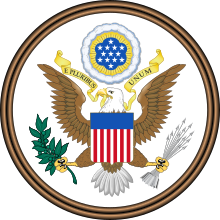E pluribus unum

E pluribus unum (
That the phrase "E pluribus unum" has thirteen letters makes its use symbolic of the original Thirteen Colonies which rebelled against the rule of the Kingdom of Great Britain and became the first thirteen states, represented today as the thirteen stripes on the American flag.
Meaning of the motto

The meaning of the phrase originated from the concept that out of the union of the original Thirteen Colonies emerged a new single nation.[8] It is emblazoned across the scroll and clenched in the eagle's beak on the Great Seal of the United States.[8][9]
Origins
The 13-letter motto was suggested in 1776 by
While
Usage on coins

| Dime E pluribus unum engraving. | |
|---|---|

| |
| Obverse: Portrait of Franklin D. Roosevelt, year and US national motto (In God We Trust) | Reverse: E pluribus unum, olive branch, torch and oak branch, face-value and country |
The first coins with E pluribus unum were dated 1786 and struck under the authorization of New Jersey by Thomas Goadsby and Albion Cox in Rahway, New Jersey.
According to the
In a quality control error in early 2007 the Philadelphia Mint issued some one-dollar coins without E pluribus unum on the rim; these coins have since become collectibles.
The 2009 and 2010 pennies feature a new design on the back, which displays the phrase E pluribus unum in larger letters than in previous years.[1]
Other usages
U.S. Government
- Besides the United States Great Seal's obverse and most American coins, the motto appears over the tribune in the Supreme Court and the Army, and on the state flags of Michigan, New York, North Dakota, and Wisconsin.
Other countries' governments
- It appears on the logo of the Shire of Boulia, Queensland, Australia.
- The motto appears on the coat of arms of the city of Mongaguá in Brazil.
- A variant of the motto, unum e pluribus is used by the Borough of Wokingham in Berkshire, England.[19]
- This motto has also been used by the Scoutspataljon, a professional infantry battalion of the Estonian Defence Forces, since 1918.
Sports
- The motto appears on the logo of the United States Golf Association.
- The motto is used on the emblem of the Portuguese sports club
Arts and media
- This motto has also been used in the Eden novel of Stanislaw Lem(cited by Doctor).
- E Pluribus Unum is a march by the composer Fred Jewell, written in 1917 during World War I.
- The Wizard of Oz's title character uses the motto to describe his (and Dorothy's) homeland of Kansas: the land of e pluribus unum.
- Roman Legion Hare: "E Pluribus Uranium".
- "E unibus pluram" is the title of a 1996 essay by David Foster Wallace which appears in the collection A Supposedly Fun Thing I'll Never Do Again.
- In 2001, following the I am an American"; near the end of the PSA, a black screen shows and the phrase "E pluribus unum" is seen with the English translation underneath.[22]
-
The arms of Mongágua, Brazil
-
The logo of Estonian Scouts Battalion
See also
References
- ^ a b "E Pluribus Unum". treasury.gov. Retrieved March 29, 2012.
- ^ a b "E Pluribus Unum - Origin and Meaning of the Motto Carried by the American Eagle". Greatseal.com. November 28, 2011. Retrieved April 28, 2012.
- ^ "E Pluribus Unum 2". Collins English Dictionary: Complete & Unabridged 10th Edition. HarperCollins. Retrieved December 23, 2012.
- ^ "E Pluribus Unum". Retrieved March 29, 2012.
- ISBN 9781107071827.
- ^ "Text of H.J.Res. 396 (84th): Joint resolution to establish a national motto of the United States (Passed Congress version) - GovTrack.us". GovTrack.us.
- ISBN 9780803261426. Retrieved January 10, 2021.
- ^ a b The Great Seal of the United States - U.S. Department of State, Bureau of Public Affairs (Page: 6)
- ISBN 9780803261426. Retrieved January 10, 2021.
- ^ "The Gentleman's Magazine". Encyclopædia Britannica.
- ^ "[Title page]". The Gentleman's Magazine, and Historical Chronicle. 46. 1776 – via Google Books.
- ^ Book IV, section 8.13.
- ^ Cicero, Marcus Tullius. De Officiis. Book 1, Section 56: Project Gutenberg.
{{cite book}}: CS1 maint: location (link) - ^ Bowers, Q. David (2009). Whitman Encyclopedia of Colonial and Early American Coins. Atlanta: Whitman Publishing. p. 129.
- ^ Breen, Walter (1998). Complete Encyclopedia of US and Colonial Coins. New York: FCI Press; Doubleday. p. 78.
- ^ "Resource center faqs/coins accessed 2011-06-27". Treasury.gov. Retrieved March 3, 2012.
- ^ "Massachusetts Coppers 1787-1788: Introduction". University of Notre Dame. Retrieved October 9, 2007.
- ^ March, 1786 Petition to mint Massachusetts Coppers, source Google books. 1916. Retrieved March 3, 2012.
- ^ "The Wokingham Borough Coat of Arms". Wokingham Borough. Retrieved June 13, 2014.[permanent dead link]
- ^ Oliveira, Diogo Cardoso; Alves, José (March 1, 2019). "A história de FC Porto e Benfica nos seus emblemas" [FC Porto and Benfica's histories in their emblems]. Público (in Portuguese). Archived from the original on February 19, 2021.
- ^ "Símbolos: Emblema do SL Benfica" [Symbols: SL Benfica's emblem]. SL Benfica (in Portuguese). Archived from the original on January 4, 2024. Retrieved January 4, 2024.
- ^ "I am an American". Ad Council/GSD&M. Retrieved January 3, 2013.


